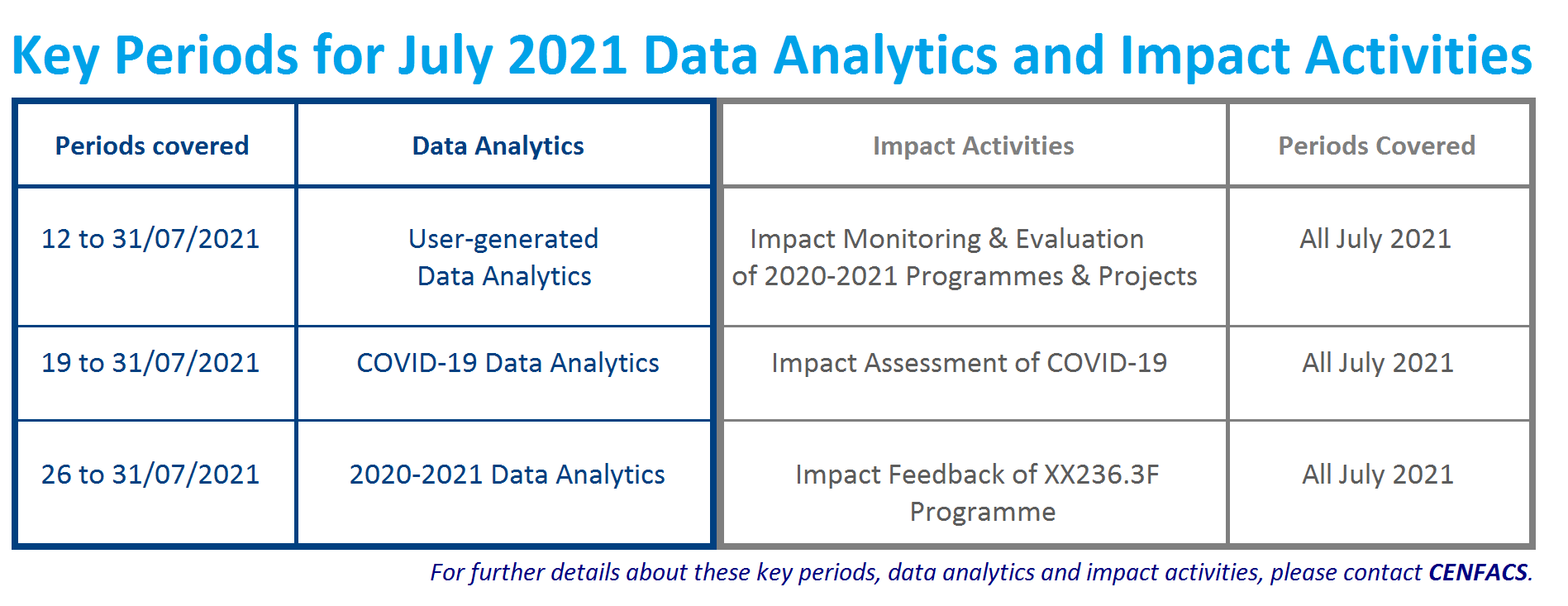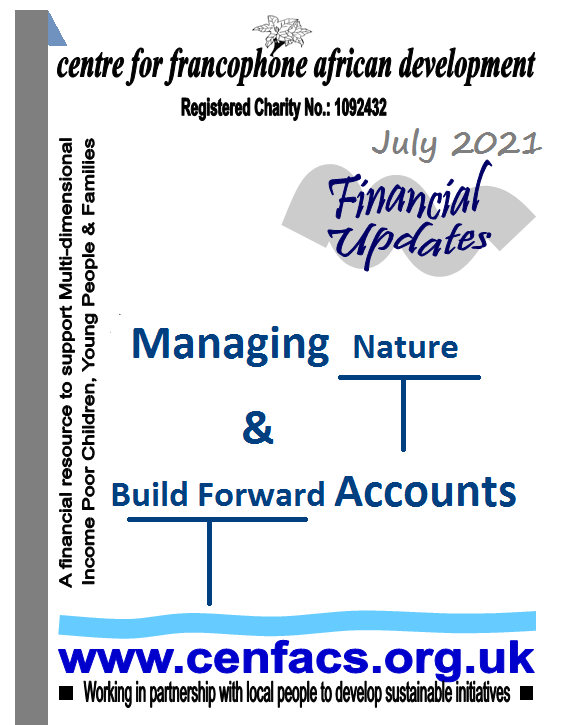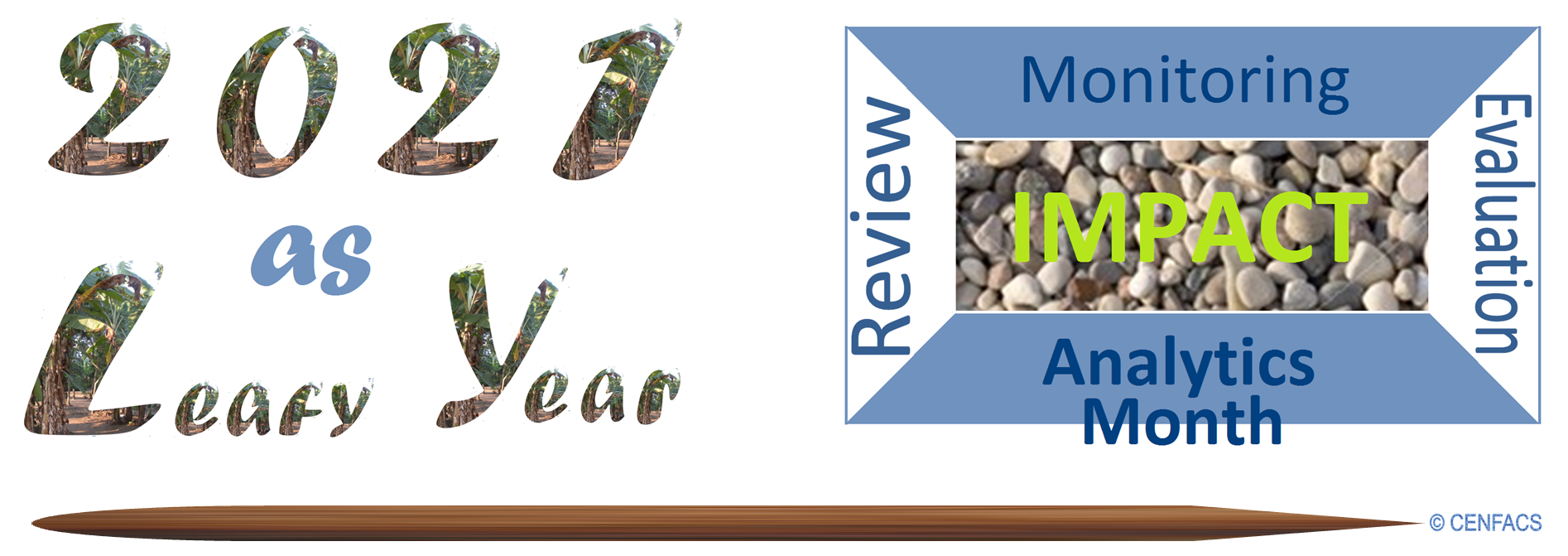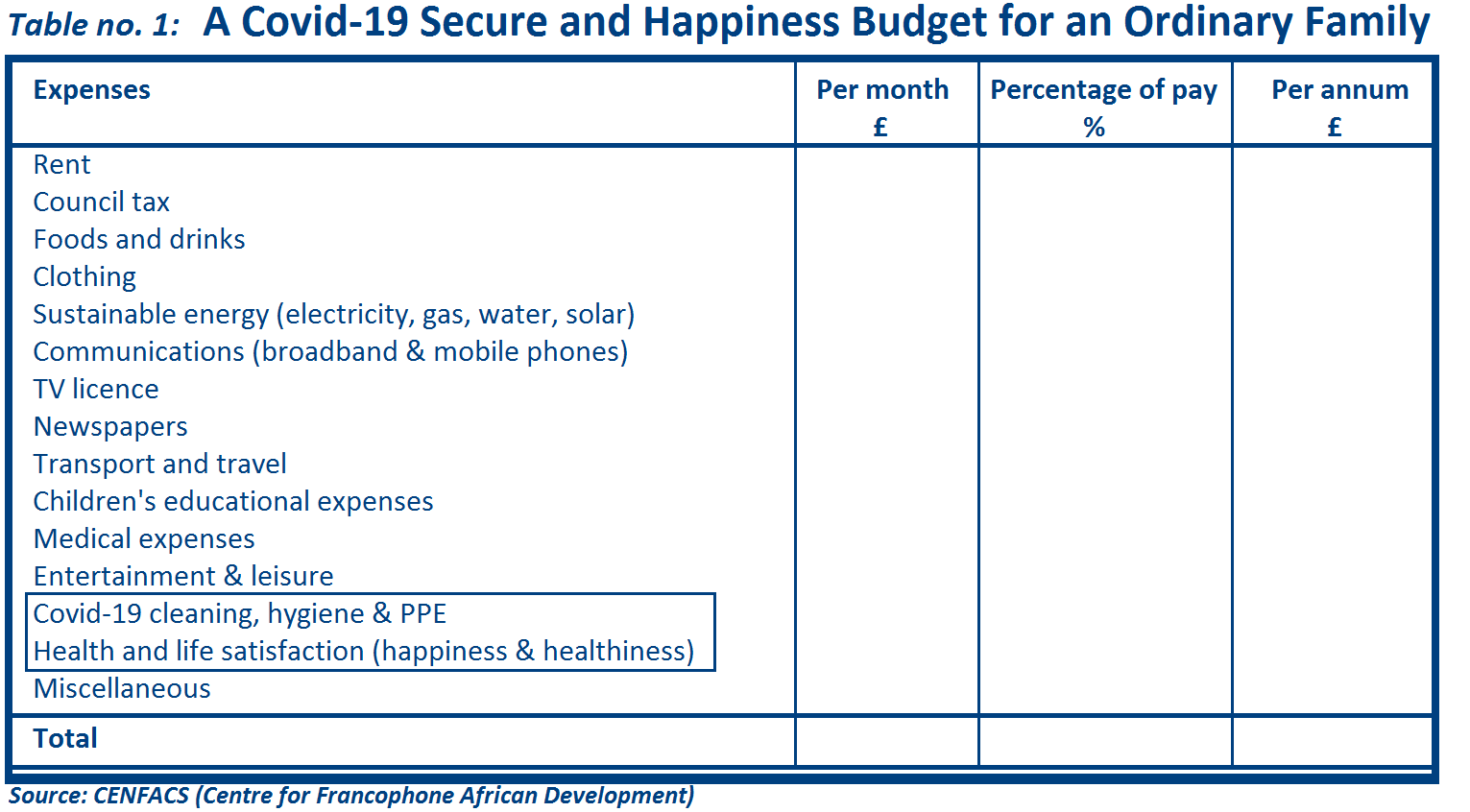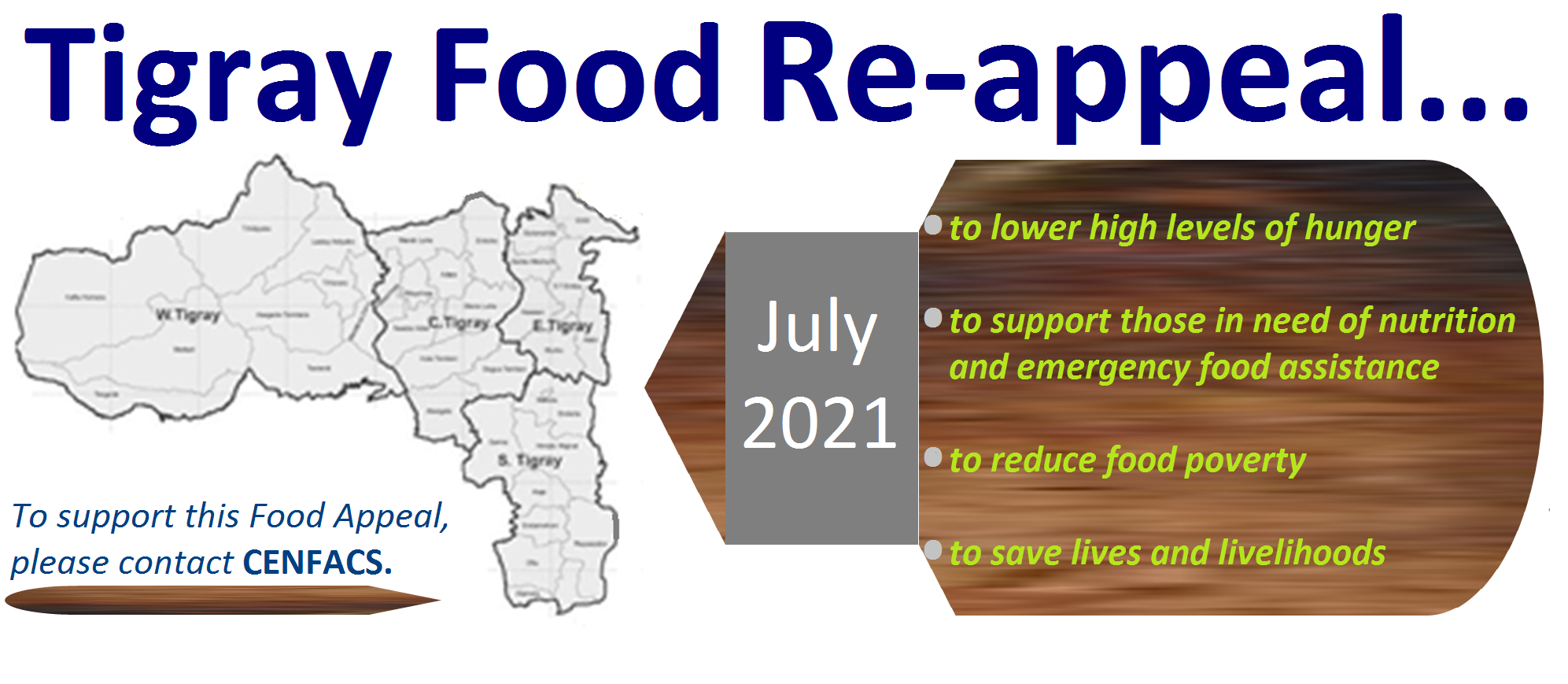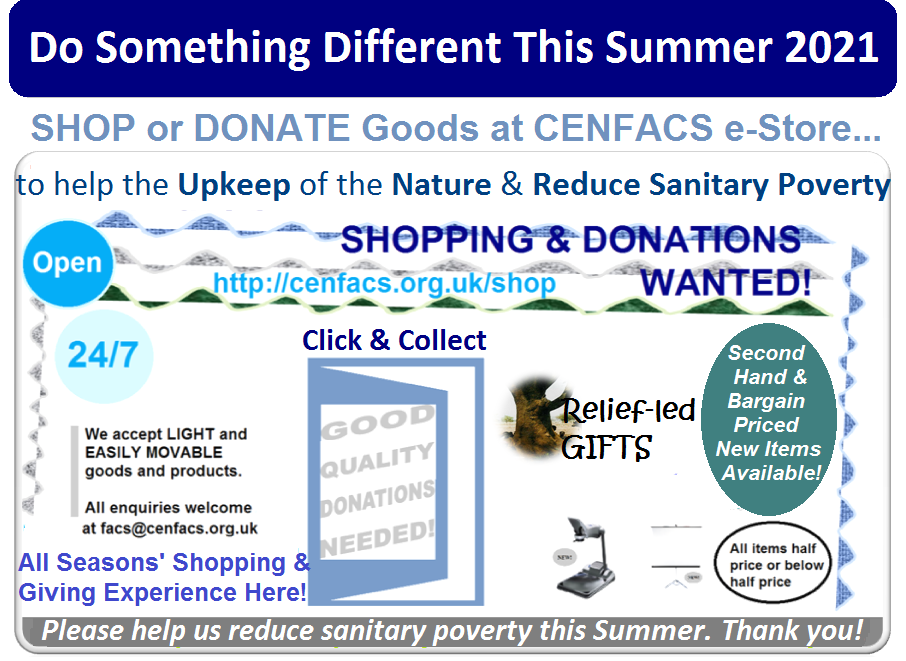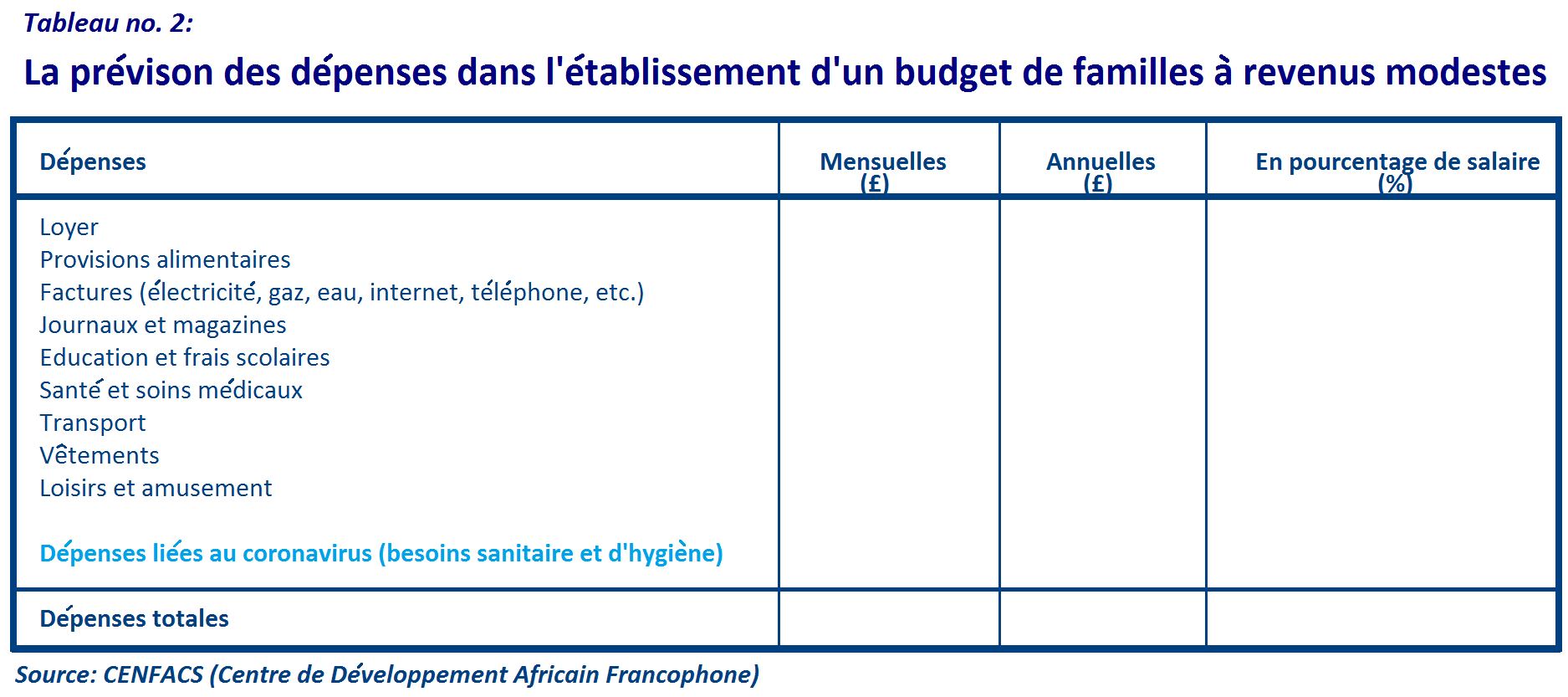Welcome to CENFACS’ Online Diary!
07 July 2021
Post No. 203
The Week’s Contents
• Analytics Month
• The Next Issue of Summer Financial Updates (Summer 2021 Edition) will be entitled: Managing Nature and Build-forward-better Accounts
• Leafy Year and Analytics Month
… And much more!
Key Messages
• Analytics Month
July is CENFACS’ Analytics month as it is the time of the year during which we conduct the impact monitoring, evaluation, review and analytics of our programmes and projects. Through this exercise, we analyse what we did over the last 345 days, seize the outputs and, if possible, capture the early impacts made.
It is the time we review what worked well, what badly worked and what did not work at all. We do it by bringing all together the programmes and projects as well as activities that made the preceding financial year. This is what we usually call All-in-one Impact Feedback and Assessment.
It is a feedback because we ask all our stakeholders to give their opinions about our work. We expect them to provide us with their unbiased, independent, true and fair views and feelings about our work. From what they feedback and what we have collected as data, we can assess or judge our performance against aims, goals and targets of poverty reduction and sustainable development we set up at the beginning of the financial year. This also guides us to adjust and redevelop our programmes and projects. In doing so, this gives us the opportunity to predict and plan future activities while rebuilding and reconnecting with stakeholders.
For more information about All-in-one Impact Feedback and Assessment or CENFACS’ Analytics Month, please read under the Main Development section of this post.
• The Next Issue of Summer Financial Updates (Summer 2021 Edition) will be entitled: Managing Nature and Build-forward-better Accounts
How to capture financial information linked to the nature and build forward better into your household accounts
The 2021 Edition of Summer Financial Updates (SFIs), which takes stock of the 2020 Edition of SFIs, is a good insight that builds on the relationship between human harmony with the nature and the principles to build forward better together greener and cleaner from the side effects of the coronavirus pandemic. It deals with two types of accounts at household level which are: natural capital accounts and build-forward-better accounts.
• • Nature or natural capital accounts
Nature or natural capital accounts are related to the management and preservation of the nature at the level of household. They can be expressed in terms of expenses, income and saving related to natural resources and environmental assets management like water, soil, air, plants, animals and minerals. They can be translated into expenses and incomes to cover these expenses which can help to build financial statements such as household balance sheets, profit and loss account, etc.
They are interesting since many people and families are adopting nature-based solutions to consume and produce. Also, natural assets are not infinitely substitute. Therefore, better managing their accounts at household level can help to ensure that natural assets continue to provide the resources and environmental services on which households’ well-being relies upon.
• • Build-forward-better accounts
These are a set of accounts helping to ensure that the recovery from the coronavirus pandemic sits on sound and sustainable foundations that both build back better and move forward households greener and cleaner. The accounts to build forward better will be those adversely affected by the coronavirus and accidental/unintended damages caused by the containment measures meant to deal with the coronavirus. In this respect, there is not a ‘one-size-fits-all approach’. All depends on each household’s accounts and budget.
However, on average most ordinary households have seen their health and house cleaning budgets affected during the coronavirus pandemic. This is because we all have been recommended to often wash our hands, disinfect our home and its contents, wear personal protective equipment against the coronavirus, etc. They are the accounts linked to the protection against the coronavirus pandemic that include items dealing with personal hygiene, cleaning, sanitation, personal protective equipment, etc. to protect and save lives from the life-threatening and destroying impacts of the Covid-19. Spending on these items and accounts has dramatically increased for many of the ordinary households. They need to be built forward.
The 2021 Edition of SFIs is more than a foundation for households to familiarise with the kinds of good accounting and management practice about their relationship with nature while including Covid-19 effects into their family accounts and budgets. They help to build a frame or structure in the process of moving forward better greener and cleaner from the coronavirus pandemic.
The Issue does not stop there as it contains some examples of nature and build-forward-better accounts and financial statements while providing some good leads for good management and control of household budgets in terms of comparative approach between ratios.
Finally, the 2021 Edition of SFIs facilitates our understanding of the complex information surrounding the current economic situation which is still dominated by the legacies of Covid-19, while providing some tips and hints to adapt, mitigate and build forward better household economics. In this respect the Issue is both an update to the current economic situation and a scenario analysis in terms of what this situation means for the poor and disadvantaged people.
To find out more about this resource, please contact CENFACS.
• Leafy Year and Analytics Month
• • What Leafy Year and Analytics Month are about
Leafy Year is our dedication of 2021 as a leafy year or a year of leaves of poverty reduction. As we are in a global situation of a challenging pain brought by the coronavirus pandemic, leaves can be a way of relieving us from pains brought by the coronavirus and of building forward better lives.
Analytics Month is the month of the discovery, interpretation and communication of meaningful patterns and trends in data. It is the month during which we try to gain insight of the meaning of data from the preceding financial in terms of poverty reduction and sustainable development.
• • Possible links between Leafy Year and Analytics Month
This month, we are doing some analytics via leaves. We are looking at how leaves can help us in discovering, interpreting and communicating meaningful patterns in data about poverty reduction and sustainable development. In doing so, this will enable us to identify the linking elements or connectors that will enable to establish some relationships between our Leafy Year and Analytics Month.
The findings of this exercise will be summarised and published in our different documents (e.g. annual and quarterly reports, project reports, other financial statements, etc.). They will as well be presented or showcased during eventful occasions such as exhibitions, fairs, expositions, festivals, markets, etc. These presentations can be physical or online or both.
To enquire or make query about CENFACS’ Leafy Year and Analytics Month, please contact CENFACS.
Extra Messages
• Happiness and Healthiness Budgets for Poor Children, Young People and Families
It is always hard to ask those (like poor children, young people and families) who experience poverty and literally have no income or income below the poverty line, to write a budget about anything, especially for their happiness or healthiness or even holidays.
Whether or not a poor person is happy or healthy or takes holidays; they need happiness, healthiness, holiday budget or simply a budget to plan their sources of income and ways of meeting their expenses over a particular time of the year (e.g. Summer holiday). The same person needs to plan how they are going to meet basic life-sustaining health costs.
Although we have the National Health Service (NHS) in the UK, there are other health costs which are not covered by the NHS. These additional and basic life-sustaining health costs may include: personal hygiene, cleaning and disinfecting costs related to the protection against the Covid-19 and other bacteria. These additional costs can be included into the happiness and healthiness budgets.
One can as well integrate other items of happiness (like health and life satisfaction) and the metrics of healthiness and well-being into their budget. They can do it by putting together the items of income per capita (or monetary income) and non-monetary ones into happiness or well-being budget.
The happiness and healthiness budgets, or put it simply holiday and basic health accounts, help to assess where and how much help is needed. Therefore, poor people and families need to do their income sums and build them into their happiness, holiday and basic health expenses budgets and accounts or simply Summer expenses budgets or accounts.
To discuss your happiness, healthiness and Summer holiday budgets, please contact CENFACS.
• Tigray Food Re-appeal
This is a continuous appeal regarding the food crisis and hunger situation in Tigray. We are carrying on in appealing because the critical situation in Tigray does not show any signs of abating.
According to local sources, more than 400,000 people in Tigray are now suffering from famine, 1.8 million others on the brink and 33,000 children are severely malnourished. Acute food insecurity and hunger continue to claim their victims there.
The data from the various sources of information tell the same story and speak for the appalling condition of the peoples of Tigray. We know that at this challenging time, it is not easy to support many causes even deserving ones. However, this is despicable situation that deserves serious attention and help.
Therefore, CENFACS would like to re-appeal to you to help reduce the drivers of food crisis in Tigray, which are conflict and insecurity.
CENFACS hopes you will without hesitation act upon this food re-appeal to create and innovate so that the food sufferers in Ethiopia’s Tigray can get access to humanitarian support, which has been extremely restricted so far, and to food as well as navigate their way to sustainable and inclusive peace.
You can directly help the peoples of Tigray without contacting CENFACS. However, to discuss this re-appeal and the previous ones, please contact CENFACS.
• Help CENFACS’ Charity e-Store to Help Reduce Poverty
CENFACS’ Charity e-Store is still opened since the easing of non-essential retail restrictions and the unlocking of the charity retail sector restarted.
We are following the strict restrictions and guidance regarding the control and surveillance of Covid-19 and its variants, as well as the protection and saving of lives.
For the health and safety of everybody, all goods donations will be quarantined for at least 72 hours.
Our enhanced sanitation and cleaning methods and practices are firmly in place and constantly reviewed depending on the latest information received on the COVID-19 matter.
We hope you are doing the same in the interest of public health and safety.
Please do not hesitate to donate goods or purchase what is available at CENFACS’ Charity e-Store.
Many lives have been threatened and destroyed by the coronavirus pandemic. The coronavirus pandemic variants continue to pose economic and health life-threatening and –destroying threats and damages. Those who managed to survive this health disaster, they need help. We need help to help them come out poverty and hardships caused by the coronavirus pandemic.
To donate or purchase goods, please go to: http://cenfacs.org.uk/shop/
Main Development
• Impact Monitoring, Evaluation, Review and Analytics
The name of the July game at CENFACS is Impact Monitoring, Evaluation, Review and Analytics. July is the month during which we conduct our impact monitoring, evaluation, review and analytics of the projects and programmes we delivered during almost last 11 months and 2 weeks.
Before giving the contents of the Analytics Month, let us re-explain the key words we are using for the purpose of this Analytics month.
• • Key Words for the Analytics Month
There are five key words we are using which are: impact, monitoring, evaluation, review and analytics.
=> Impact
Normally, it takes a considerable amount of time to get the real impact of any intervention, project and programme. However, because we are talking about finding out what projects and programmes have achieved, it makes sense to clarify what we mean by impact.
To do that, we are going to borrow the definition of impact from the Organisation for Economic Cooperation and Development (OECD). The OECD (1) differentiates ex ante impact from ex post impact. This is what it argues.
“Ex ante impact analysis is the needs analysis and planning activity of the policy cycle. It is a prospective analysis of what the impact of an intervention might be, so as to inform policy making”.
“Ex post impact assessment is the evaluation and management of the policy cycle. Evaluation aims to understand to what extent and how a policy intervention corrects the problem it was intended to address. Impact assessment focuses on the effects of the intervention, whereas evaluation is likely to cover a wider range of issues such as the appropriateness of the intervention design, the cost and the efficiency of the intervention, its unintended effects and how to use the experience from this intervention to improve the design of future generations”.
The above definitions help to understand the scope and scale of the impact of most interventions.
As far as CENFACS is concerned, we will be doing evaluation activities for some programmes and projects; and impact assessments for others. This is because impact assessment is mostly a theory-based activity and has a narrow and tightly-defined focus. Where we need to design evaluation questions and use evaluation techniques, we will do evaluation. Where there is a need for a tightly-defined focus, we will do impact assessment.
We are as well considering that the initiative for change comes from project users or beneficiaries not from CENFACS or CENFACS’ projects or programmes. This is because the impact analysis model of change we are using is a non-linear one. Despite this non-linearity of the theory of change used, our impact analysis will still be based on causality and attribution approach.
=> Monitoring and evaluation
We are going to use the definition of monitoring and evaluation as given by Kersty Hobson, Ruth Mayne and Jo Hamilton (2) in their “A Step by Step guide to Monitoring and Evaluation”. They define monitoring as
“the collection and analysis of information about a project or programme undertaken while the project or programme is on-going”. (p. 5)
They also define evaluation as
“the periodic, retrospective assessment of an organisation, project or programme that might be conducted internally or by external independent evaluators”. (p. 5)
From these two definitions, it is understood that monitoring is an on-going process whereas evaluation is a periodic or discrete one.
=> Review
We have referred to an online source from method123.com (3) for the meaning of this fourth key word. This online source defines review as
“an assessment of the status of a project at a particular point in time”.
From this online perspective, we have been performing a project management review at the end of each phase of our projects and programmes. We have been verifying whether or not we have met the objectives. If so, then a decision needed to be approved to proceed to the next project or programme phase.
July is the month we put together all these project reviews conducted while doing the last reviews for those projects and programmes pending for a final review.
=> Analytics
There are many approaches to analytics. In the context of our July work, we have selected an explanation from an online dictionary (4) which is as follows:
“the patterns and other meaningful information gathered from the analysis of data”.
This kind of analytics will help us to better deliver a user experience for our projects and programmes.
• • The analytical process within CENFACS
We have been continuously and at discrete points in time tracking what has been happening within our programmes and projects while using the data collected to inform programme and project implementation as well as day-to-day management and decisions during the above named period. However, in July this monitoring exercise becomes more intense.
Likewise, we have been periodically assessing objectives of our planned, on-going, or completed projects, programmes, or policies. During these evaluation processes, we have tried to selectively answer specific questions related to the design, implementation, and results of our programmes and projects.
In July, these evaluation activities become further pronounced as we assess what these programmes and projects have achieved in relation to the overall objectives we set up for them. The results of this evaluation are fed back to improve these programmes and projects, or alternatively to develop new ones.
Still in July, we critically examine, reappraise or reconsider our objectives and policies to achievements, and see if there is any progress or set back. This review enables us to improve as well.
Throughout the year, we work to finding out, interpret and communicate patterns in data in a meaningful way to the work of CENFACS. We apply those patterns in our decision making process. In July, we put extra emphasis on this analytics which becomes very profound.
Briefly, July is the time we do our Summer tracking by reconsidering the value and relevancy of our work, let one the overall state of our charitable work. It is in this period of the year that we carry out what we call All-in-One Impact Feedback and Assessment. In other words, we try to listen to our stakeholders while tracking or capturing the early impacts of our work by considering all the pieces together as one.
One of the key tools we use to do our impact analysis is CENFACS Analytics Dashboard.
• • What is CENFACS Analytics Dashboard?
CENFACS Analytics Dashboard is an information management tool that tracks, analyses and displays key performance indicators, poverty reduction diagnostics, poverty relief metrics/dashboards, results from CENFACS’ poverty relief league, etc.
• • • What else does CENFACS Analytics Dashboard offer?
√ It monitors the health of CENFACS in terms of the relationships of support received to outputs and outcomes generated.
√ It provides as well charts and summaries about some of the campaigns conducted.
√ It enables to discover and identify poverty reduction problems from the examination of symptoms it helps find.
√ It assists in engineering analytical solutions to the problem of reducing poverty.
√ It finally helps to retrieve information from CENFACS repository about the resources to help users and supporters.
For example, during the early stage of the coronavirus pandemic, we used CENFACS Analytics Dashboard to check the health of CENFACS and state of running of CENFACS’ projects and programmes. This checking enabled us to know the extent to which the coronavirus pandemic affected the running of CENFACS and its services. Knowing the distributional effects of the coronavirus pandemic on our projects and programmes, this knowledge helped us to reorganise these projects and programmes differently.
For more on CENFACS Analytics Dashboard, please contact CENFACS.
• • Analytics of Leafy Year as an Example of Analytical Process within CENFACS
• • • What is the analytics of CENFACS’ Leafy Year?
The analytics or tracking of Leafy Year is the 6-month analysis and turning of raw data insight for making better decisions in terms of helping to reduce poverty and enhance sustainable development. To make this possible, we have created a journal of creative activities carried out so far to mark 2021 as a Leafy Year. This journal is also a record of data.
• • • Journal of 2021 activities as a Leafy Year: What leaves can do for those living in poverty
⇒ January 2021
Activity: Responsible consumption to help in keeping harmony between our consumption of leaves and nature
Analytics quantitative indicator: Quantity or percentage of wasted or conserved leaves during consumption
⇒ February 2021
Activity: Recycling fallen leaves to help to reduce pressure on the environment and to contribute to the circular economy
Analytics quantitative indicator: Rate of recycling of fallen leaves
⇒ March 2021
Activity: Climate action to reverse new patterns and trends so that trees continue to draw carbon dioxide from the air and leaves can rediscover their seasonal course of cycle
Analytics quantitative indicator: Number of actions taken to reverse these patterns
⇒ April 2021
Activity: Protection of leaves so that their medical properties can continue to help human from and cure diseases
Analytics quantitative indicator: Number of lives saved from leaves as medicine
⇒ May 2021
Activity: Use of leaves to tell and express stories of poverty reduction and sustainable development
Analytics qualitative indicator: Changes that happen to our users from stories via leaves
⇒ June 2021
Activity: Raising creative and productive capacities via leaves in the process of poverty reduction and sustainable development
Analytics quantitative indicator: Rate of conversion of the power of leaves into poverty reduction and the quality of life
One can quantify and gain insight of the meaning of the data about the last 6 months of Year of Leaves from this journal of creative activities and make good decision on how to better help to reduce poverty and enhance sustainable development.
• • All-in-one Impact Feedback and Assessment for July 2021
This month, we will be conducting three levels of Impact Assessment:
(a) Impact monitoring and evaluation of the programmes and projects we ran in the last financial year
(b) Impact assessment of the enduring coronavirus pandemic on CENFACS
(c) Impact feedback about our XX236.3F Programme
This Impact Assessment will be ex post. And the evaluation related to this exercise will aim to understand the extent to which and the way in which our projects and programmes corrected the problems of poverty and unsustainable development amongst our intended beneficiaries.
Let us briefly summarise the three levels of impact assessment to be conducted.
(a) Impact monitoring and evaluation of the programmes and projects we ran in the last financial year
As the title of impact indicates, it will about putting together in the form of one piece of work all the results of monitoring and evaluation activities we have conducted for programmes and projects we ran in the last financial year.
(b) Impact assessment of the enduring coronavirus pandemic on CENFACS
We shall continue to seize the impact of Covid-19 on CENFACS, particularly on CENFACS’ 2020s Poverty Reduction Tools and Programme and Development Agenda. We shall as well examine how the rollout of COVID-19 vaccine has impacted on CENFACS.
(c) Impact feedback about our XX236.3F Programme
Like last year, this year’s All-in-One Impact Feedback and Assessment will be extended to include our XX236.3F programme as we are in the month of Monitoring and Evaluation.
XX236.3F is our 2020 to 2030 to 2063 Follow up Programme. We are following the implementation of the International Climate Change Agreement (or the Paris Treaty), the Istanbul Declaration, the United Nations 2030 Agenda and Sustainable Development Goals, and Africa’s Agenda 2063. The four of them make up our XX236.3F programme.
We need to acknowledge that Covid-19 has not made and is not making easier to get the impact feedback about our XX236.3F Programme. Despite this difficulty, we are still conducting this impact feedback and assessment.
In brief, we shall conduct a follow-up and examination, look back and analyse data on the overall projects and programmes delivered during the above stated period, while keeping implementing our XX236.3F programme.
We shall soon publish the programmes and projects making this year’s Analytics. In meantime, for any enquiries about the Analytics month, please contact CENFACS.
_________
References
(1) https://www.oecd.org/sti/inno/what-is-impact-assessment-OECDImpact.pdf (accessed July 2021)
(2) https://www.geog.ox.ac.uk/research/technologies/projects/monitoringandevaluation.html (accessed July 2021)
(3) https://www.method123.com/initiation-phase-review.php (accessed July 2021)
(4) https://www.dictionary.com/browse/analytics (accessed July 2021)
_________
Help CENFACS keep the Poverty Relief work going this year.
We do our work on a very small budget and on a voluntary basis. Making a donation will show us you value our work and support CENFACS’ work, which is currently offered as a free service.
One could consider a recurring donation to CENFACS in the future.
Donate to support CENFACS!
FOR ONLY £1, YOU CAN SUPPORT CENFACS AND CENFACS’ PROJECTS, JUST GO TO http://cenfacs.org.uk/supporting-us/
Thank you for visiting CENFACS website and reading this post.
Thank you as well to those who made or make comments about our weekly posts.
We look forward to receiving your regular visits and continuing support throughout 2021 and beyond.
With many thanks.

